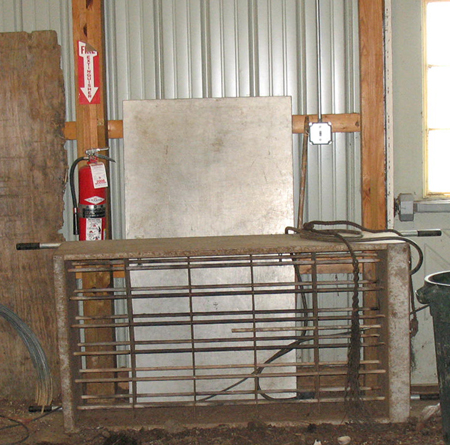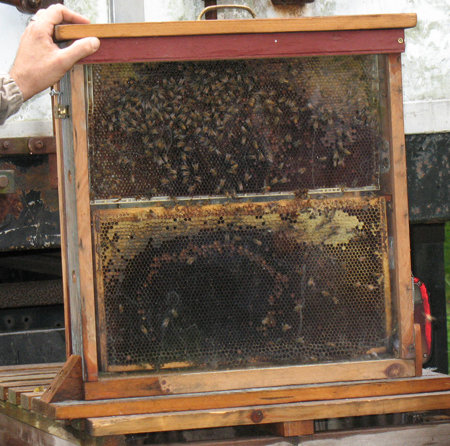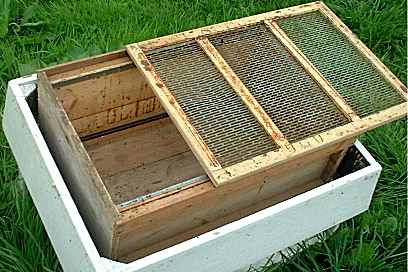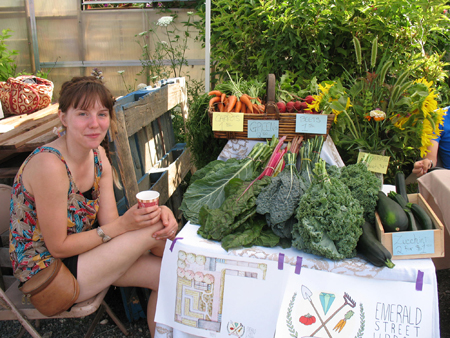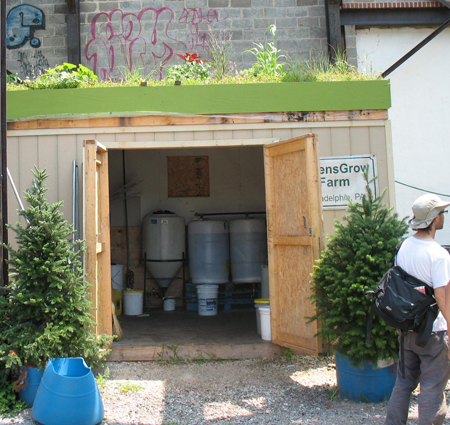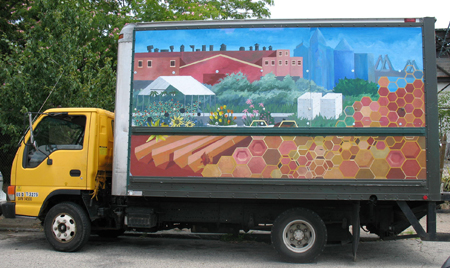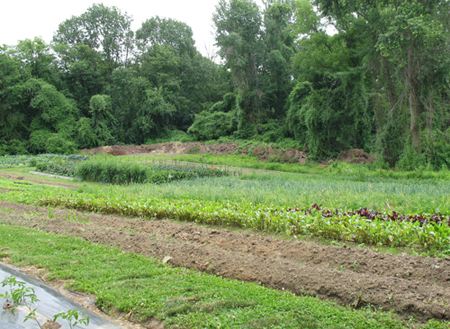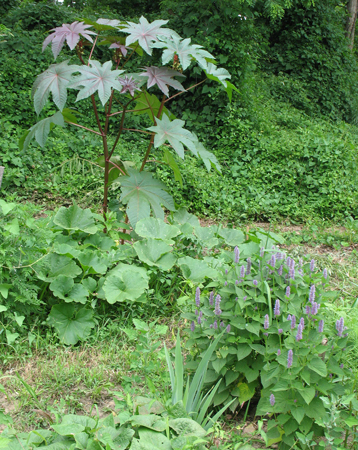Saturday July 25th saw a total of 16 interns in attendance for SAITA's Vegetable Cultivation Techniques workshop at Aimee and John Good's Quiet Creek Farm. Situated at the Rodale Institute, a few miles east of Kutztown, PA, the Goods lease 8 acres from the Rodale's 333 acres. Rodale is renowned not only for its longevity in the organic community, but also for its Farming Systems Trial (FST), the longest-running experiment comparing organic and conventional farming practices.
Founded in 1947 by J.I. Rodale, this is now a third generation farm, impressive for its tidiness and beautiful rolling hills. In fact, I was struck by the similarity to the vistas of Umbria's agrarian horizons in Italy. On a personal note, this was the highlight of our workshops, as I had wanted to visit the institute since the late 1960's, during my own early involvement with the 'back to the land' movement.
Quiet Creek operates a 225 member CSA and has on-farm pickups on tuesdays and fridays. John works the farm full-time, Aimee works part-time and takes care of their young daughter, Celia Rose. Jonathan Maier works as their full-time apprentice and there are two other full season apprentices helping out.
They also offer two 1/2 acre U-Pick fields, including flowers, that usually bring 50-60 people out at a time. They partner with other farms to offer pork, bacon, eggs, grass-fed beef, and even locally produced organic spelt flour. The objective is to make the barn shop a one-stop shopping experience. The Mennonite farmer next door sells raw milk and butter.
Because Rodale has large equipment on site, the Goods hire them to do some of the harder field work, like cover cropping. They also borrow the potato digger and planter. They make their own potting soil from compost and on the last part of our tour we viewed the compost sterilizer and turner, designed and built by the local Mennonite farmer next door, the same one who sells raw milk and butter. The screener pasteurizes at 200 degrees. John amends his compost with a butter dishful of lime, bone meal, rock phosphate, bloodmeal, greensand, using a 1 to 1 ratio of compost to lightening products; perlite, vermiculite and peat.
John works aggressively with cultivation to keep bushy type weeds like foxtail and ragweed from getting out of hand. He will go through the beds with the cultivator at least twice before seeding or transplanting. This he says, can exhaust most of the weed seeds in the top 2-3" of soil. To find out if the land is too wet, grab a handful of soil and ball and drop; if it breaks up, it's safe to work the field. Cultivation will also help to dry out the surface of wet soil, helping with disease and fungus. The resulting top 2" of soil will then help preserve moisture below. Some farmers who use no irrigation only use cultivation as a means of conserving water.
Quiet Creek and Rodale share a pond as their irrigation source with a hydrant on each of 6 pillars. There is also a pumphouse and 4" pipes @ 100 psi are sized for the 300 acre farm. There are 3 big guns on tripods for Quiet Creek, with 200' broadcasting ability for 2-3 hours. John uses Rainflo tripods and flat hoses and praises the company's prompt and personalized customer service.
He uses Typar as a heavier type of row cover; it never rips and will last much longer than the earlier products like Agronet or Reemay. Fall kale is planted under these now.
An ingenious way to roll out large row covers onto fields, John inserts a roll through the pipe, lays it onto 2 sawhorses and another person at the far end helps to unroll while it's laid onto the field:
To avoid a lot of hand weeding, John marks his rows, getting as close as possible with his cultivator. He suggests that if you don't kill a few plants, you aren't close enough. He demonstrated tractor passes on cucurbits and lettuces, using a 13" pumpkin knife on his Williams Weeder from Market Farm, showing us how to avoid swerving when going down the row, and how to raise and lower the knife to slide underneath the drip tape and plants. Keeping a 15/16" ratchet wrench in the tractor box for changing out tools can help save time. For plastic covered rows, John will remove the two middle tines with the knives facing to the outside. He cultivates his beds at least once every two weeks and tries for each week in May or June when weeds are growing their fastest.
His Holland made Lely weeder has adjustable tines that float independently. He also uses the Williams system with a rake, that flips the weeds over and gets roots up into the sun to bake. His tractor is a Kubota L245H, with the offset engine that all cultivators use. John suggests going to auctions to find this equipment since companies stopped making cultivating tractors in the mid 1980's. You can also search back to Shane LaBrake's June 16th workshop in the blog to find information on tractors. John found his at auction for about $7000, circa 1985. These tractors may be easier to find in the southern states, since they've been used more recently for tobacco cultivation. An interesting paper by a U of VT vegetable/berry specialist on the pros and cons of cultivation equipment with source addresses, can be found here.
Back in the storage barn, Aimee showed us their Planet Jr. version of a European push seeder, with three different seed plates. Read comparisons of Cole's seeder to the Earthway product here. Johnny's makes a European model that's similar to the Planet Jr.
Another nifty piece of equipment demo'd was the Flame weeder, a propane powered contraption that basically burns weeds to a crisp. Helpful for weed control and possibly for disease as well, John suggests trying this on damp weeds and wetter ground; the extra moisture helps to steam them to death. Open the propane tank before you put your backpack on. The model that John was using can be found, with a photo tour, on Flameweeders.com in West Virginia.
Hand tools include 3 different stirrup hoes and a small hand hoe from Johnny's:
The farm uses Surround on cucurbits for cucumber beetles, BT on their cabbages and broccoli for cabbage worms. Actinovate is being used for bacterial diseases and Quiet Creek is experimenting with Agriphage,for their tomatoes. Agriphage is a new bacteriophage treatment that is actually a virus, injecting its DNA into the offending bacterium, which then replicates as new 'phage'. From all the data I read online, it appears safe, although there is some concern among scientists about these viruses entering our food system and future effects on human DNA and metabolisms. (This link suggests: Although these two dsDNA viruses infect hosts from very different kingdoms, their striking similarities, from major coat protein through capsid architecture, strongly suggest their evolutionary relationship.) I'm slightly suspect of any company who is working with the Department of Defense to develop biological weaponry and Omnilytics, a biotech company in business since 1954, makes Agriphage.
Quiet Creek leases a Greenhouse from Rodale for $1000/year, but waters in exchange and ends up even. They put their lettuces underneath heatpad covered tables and once germinated bring them to the top. Garlic was drying under the tables when we walked in and it smelled like a giant pizzeria.
Rodale's bookstore is not to be missed, it's housed in a historic one room schoolhouse. I even met a couple of New Yorkers out tending their plots nearby. LingLee told me they drive out 2 hours and go back in the same day. Just to be in the country and have some fresh home grown vegetables. Now that's dedication!
Rodale and Quiet Creek are both worth a trip to see the lovely fields, the stunning demo and visitor gardens and the chance to meet the friendliest farmers around - Aimee, Celia and John.
Next SAITA workshop on Diversified Amish Farm Marketing at Ben Stoltzfus's Pleasant Pastures Organic Acres is Saturday August 1st from 11am-1pm in Honey Brook, PA. Be sure to check Maysie's website on friday, as there may be a time switch to 10am start time.
Happy growing! See schedule and addresses for workshops here.
Victoria Webb
SAITA Coordinator
vic@furiousdreams.com





